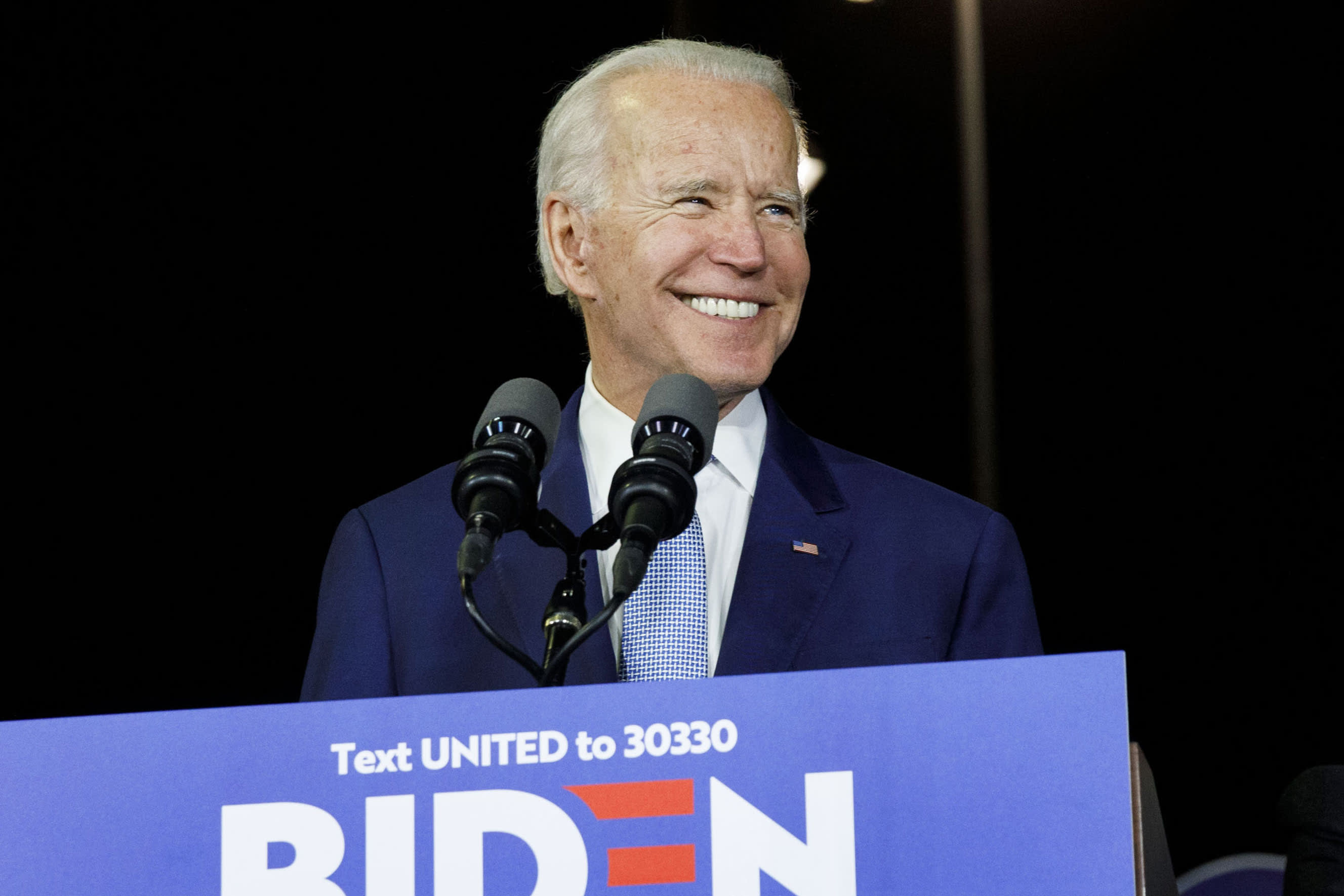A Democratic “blue wave” in November could unleash the fiscal floodgates and fuel the amount of stimulus flowing from Washington, Goldman Sachs told its clients on Monday.
The bank’s chief economist, Jan Hatzius, wrote in a note that a large Democratic Senate majority could coordinate more Covid-19 relief, infrastructure spending and new minimum wage legislation.
A “congressional Democratic majority would likely result in substantially more fiscal support. We expect that spending would increase the most under a Democratic sweep of the House, Senate and White House,” Hatzius wrote.
“This would likely include a stimulus package in Q1, followed by infrastructure and climate legislation,” he added. “In this scenario, we would expect legislation expanding health and other benefits, financed by tax increases, to pass” by the third quarter of 2021.
Former Vice President Joe Biden has proposed some $5.4 trillion in new spending over the next 10 years, according to the Penn Wharton Budget Model, a nonpartisan group at the University of Pennsylvania’s Wharton School.
The spending — earmarked for a variety of programs like infrastructure, education and housing — would be partially offset by higher taxes on households with income greater than $400,000 and a rollback in the 2017 corporate tax cut.
On net, Biden’s proposals would increase federal tax revenues by $2.4 trillion over the next decade, according to the Tax Policy Center.
Goldman Sachs also reiterated its finding that the boost to U.S. economic growth from fiscal stimulus favored by the Biden campaign would “outweigh the negative effects of tax increases, particularly in light of the fact that the increased tax revenue would go to funding new spending.”
The bank noted that public opinion polls, prediction markets and statistical models imply that Democrats are likely to win the presidency, the House and the Senate. The 2020 elections are scheduled for Nov. 3.
RealClearPolitics’ polling average gives Biden an 8.9-point advantage over President Donald Trump, 51.3%-42.4%. PredictIt odds show markets are pricing in a 63% chance Democrats control both the House and the Senate after the 2020 election.
U.S. President Donald Trump speaks during a campaign event at the Ocala International Airport on October 16, 2020 in Ocala, Florida.
Joe Raedle | Getty Images
Economist Hatzius said a Democratic sweep would likely pass at least three major pieces of legislation with “substantial” fiscal stimulus.
The first and most urgent would be Covid-19 relief. Goldman Sachs estimates that a Democratic White House and Congress would pass stimulus on the order of $2.5 trillion concentrated in 2021 with some spending rippling into subsequent years.
The second initiative would likely be an infrastructure bill, though the components of that package are less clear. The Biden campaign has outlined $2 trillion worth of infrastructure and climate-related spending.
The third bill would be a so-called reconciliation bill that provides new benefits in several areas including improved Affordable Care Act benefits, ambitious plans for child care, and greater spending on education.
“Infrastructure might take longer, but would probably become law by September, when the recent one-year extension of the transportation infrastructure program expires,” Hatzius wrote.
“Tax and benefit reconciliation legislation would likely start closer to mid-year, as Congress would first need to approve a budget resolution and then debate the details of the bill,” the economist added.
Though Democrats are laser-focused on electing Biden, Goldman explained that, in this election, the Senate is the key to controlling the federal coffers.
That’s because Trump, should he win reelection, would likely work with congressional Democrats on big-ticket agenda items.
Questions over Trump’s appetite for further spending have faded in recent weeks as the president’s repeated calls for more stimulus reinforce House Speaker Nancy Pelosi’s $2.2 trillion package and undermine calls for austerity from his own party.
While Trump has demanded lawmakers “Go big or go home!!!” with a large stimulus deal, Senate Majority Leader Mitch McConnell has tried to rein in the president.
“He’s talking about a much larger amount than I can sell to my members,” McConnell said of Trump last week while touting the GOP’s far-smaller, $500 billion proposal.
But if Democrats should win a majority in the Senate and control both chambers, the bar for additional federal support is all but removed even if Trump remains in the White House, Hatzius wrote.
“Fiscal policy differences between Republicans and Democrats in the Senate are greater than differences between the presidential candidates,” Hatizus wrote. “Recent negotiations over a COVID-19 relief package demonstrate this clearly, as the Trump Administration’s $1.8 trillion offer and Speaker Pelosi’s $2.4 trillion request are much closer to each other than either is to the $500bn Senate Republican proposal.”
“Regardless of who wins the White House, if the Senate remains under Republican control, we would expect Congress to enact a stimulus proposal much closer to the current Senate Republican proposal than to either President Trump’s or Speaker Pelosi’s,” the economist told clients.
Though gauging the total economic boost from spending programs can be tricky, Hatzius has said that a “blue wave” would force Goldman Sachs to upgrade its near-term forecasts.
He wrote earlier in October that a Democratic sweep would virtually guarantee another Covid package and result in an increase in GDP of 2 to 3 percentage points based solely on that stimulus. The firm sees a 3.5% decline in GDP in 2020 and a 5.8% annualized increase in full year 2021.
